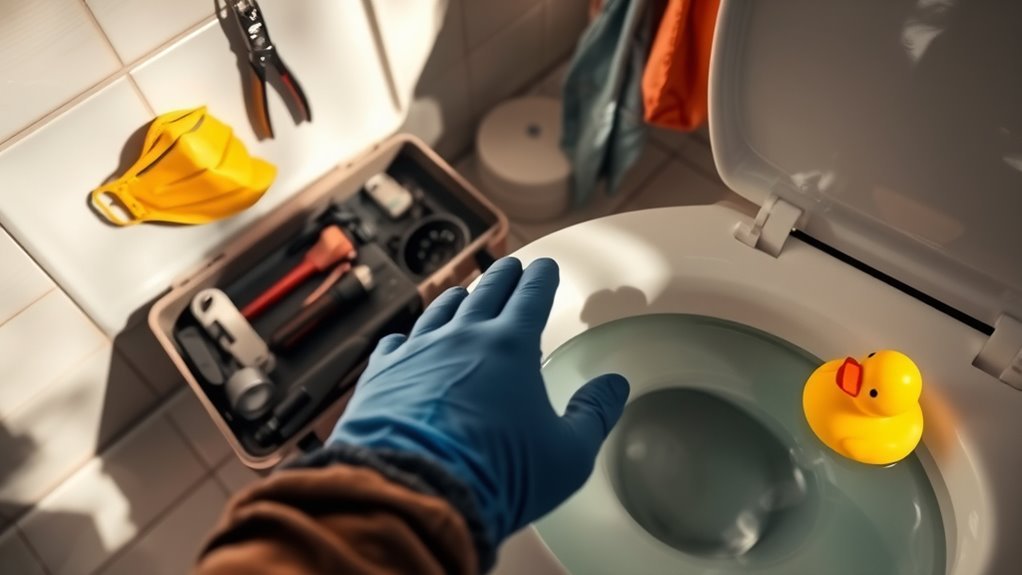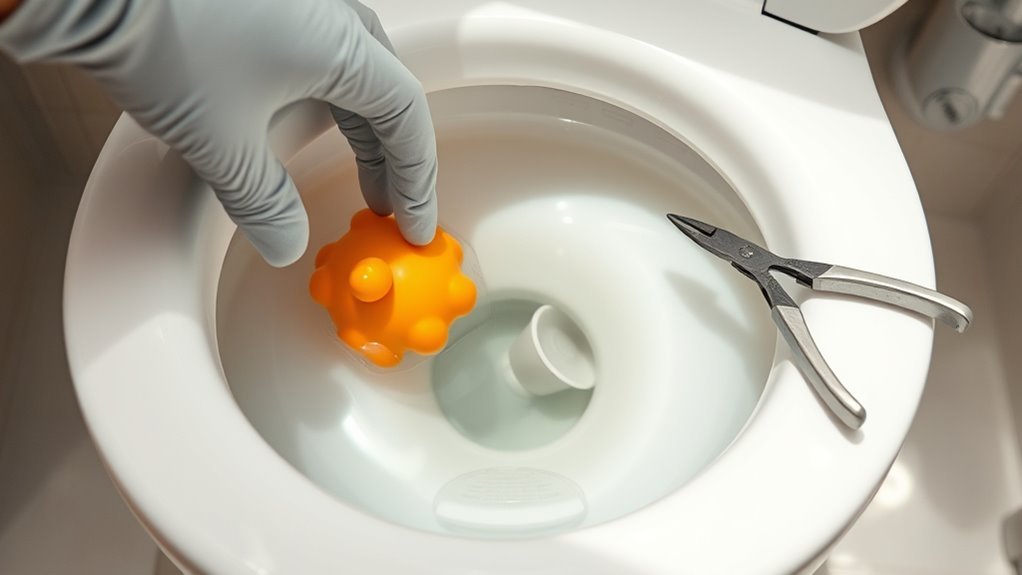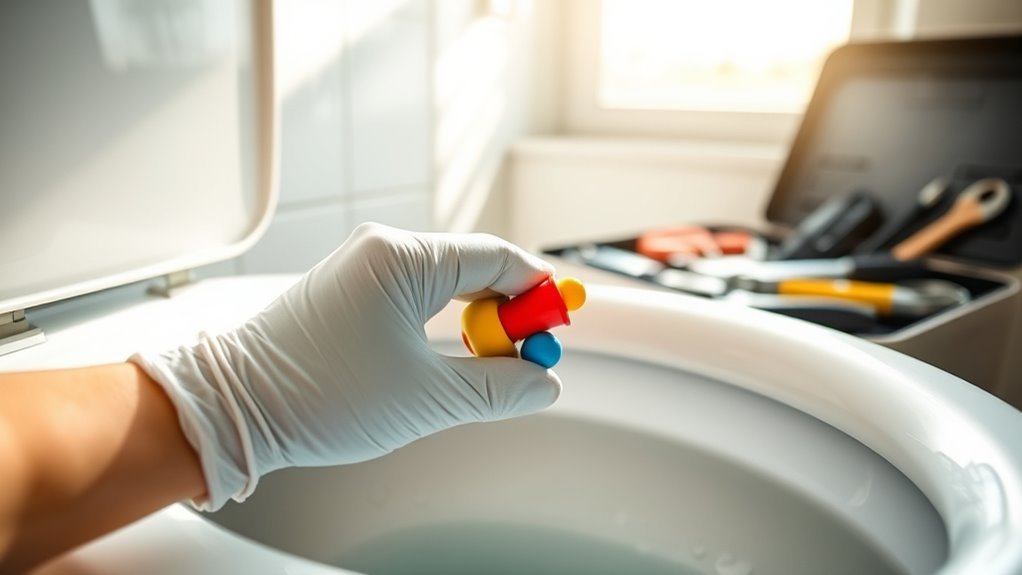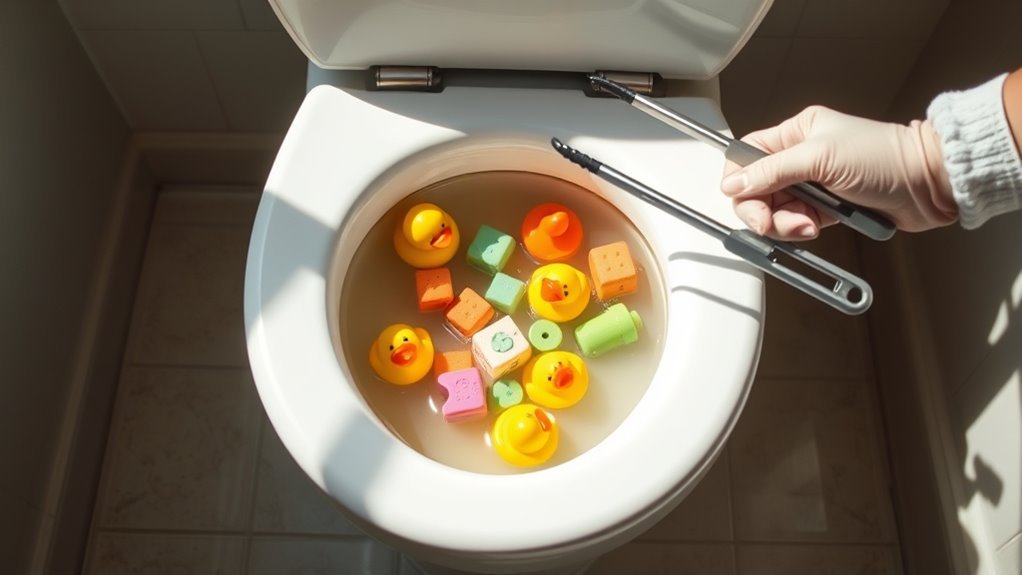Removing Baby Items From Toilet Effectively
If a baby item falls into the toilet, don’t flush—it can push the item deeper. Put on gloves, use long tongs or a grabber to gently retrieve it, and consider a toilet auger or plunger if needed, taking care not to cause damage. Afterward, clean and sanitize the item thoroughly. If the item’s stuck or the toilet clogs, calling a plumber is best. Keep toilets covered to prevent repeats, and discover detailed steps to handle this safely and effectively.
Assessing the Situation and Safety Precautions

Before you try to retrieve any baby items from the toilet, it’s important to carefully assess the situation to avoid making it worse. Start with a thorough situation evaluation: consider the item’s size, material, and how deep it might be lodged. This helps you decide the safest, most effective approach without causing damage. Always prioritize your safety and hygiene by wearing appropriate safety gear, like gloves and protective eyewear. This not only protects you from bacteria but also gives you the confidence to act swiftly and decisively. Remember, rushing in without proper preparation can lead to plumbing problems or injury. Taking a moment to evaluate the situation and gear up sets you free from unnecessary risks and helps you handle the retrieval smoothly and responsibly.
Tools Needed for Retrieval
You’ll need a few essential tools to retrieve baby items from the toilet safely and effectively. Start with sturdy retrieval tools like long tongs or a grabber tool designed to reach deep without damaging the item or the toilet. A flashlight helps you see clearly inside the bowl, ensuring you don’t miss anything. Don’t forget safety gear: waterproof gloves protect your hands, and disposable shoe covers keep germs at bay. Having a small bucket or container on hand lets you place recovered items without further contamination. These practical tools give you the freedom to act confidently and efficiently, minimizing mess and stress. Preparing with the right retrieval tools and safety gear means you’re ready to handle the situation calmly and safely every time.
Step-by-Step Guide to Removing Items Manually

Although the thought might make you uneasy, retrieving baby items from the toilet manually is often the quickest way to resolve the issue. First, protect yourself by wearing rubber gloves to maintain hygiene. Next, avoid flushing again to prevent the item from moving further. Then, carefully reach into the toilet bowl using manual retrieval techniques—slow and steady movements help prevent pushing the item deeper. Grasp the baby item firmly but gently to avoid damage. Once removed, rinse it off thoroughly if it’s salvageable or dispose of it if not. Finally, clean and disinfect the toilet area and wash your hands well. By mastering these steps, you reclaim control and freedom, handling baby item removal efficiently without waiting for professional help.
Using a Toilet Auger or Plunger
If manually retrieving the baby item isn’t an option or feels too uncomfortable, using a toilet auger or plunger can be an effective alternative. With a toilet auger, you’ll insert the flexible cable into the bowl and gently twist to hook or push the item free. This tool is designed with plumbing basics in mind, so it won’t damage your pipes while helping you regain control. Alternatively, a plunger creates suction to dislodge the blockage, often freeing stuck objects without much hassle. Both tools are essential for basic toilet maintenance, giving you the freedom to handle minor clogs yourself. Just make sure to use them carefully to avoid pushing the item further down or causing damage. These solutions keep you empowered and your toilet functional.
When to Avoid DIY and Call a Professional

If your toilet remains clogged after a few attempts or you notice water backing up from other drains, it’s time to call a professional. Trying to fix serious blockages yourself can cause damage or worsen the problem. Knowing when to stop and get expert help can save you time and costly repairs.
Signs to Call Experts
When you’ve tried simple methods to retrieve a baby item from the toilet without success, it’s time to contemplate calling a professional. One clear sign is if you notice persistent signs of blockage—like slow draining water or repeated backups. If the toilet keeps clogging despite your efforts, it’s a signal that the problem is deeper than you can handle. Also, if you’re uncertain about the item’s location or worried about causing damage, expert assistance is your best bet. Professionals have the right tools and experience to free your pipes without creating bigger issues. Remember, knowing when to call an expert isn’t giving up; it’s about protecting your home and regaining your freedom from plumbing headaches quickly and safely.
Risks of DIY Attempts
Knowing when to call a professional helps you avoid costly mistakes that can happen during DIY attempts. While it’s tempting to fix things yourself, DIY hazards like damaging pipes or worsening clogs are common. If the baby item is lodged deep or the toilet shows signs of leaks or cracks, these emergency risks escalate quickly. Trying to force removal without the right tools or expertise might lead to expensive repairs or water damage. You value your freedom, so don’t get stuck dealing with preventable problems. Instead, recognize when the situation is beyond simple fixes and call a plumber. They have the skills and equipment to handle the mess safely and efficiently, saving you time, stress, and extra costs.
Preventive Measures to Avoid Future Incidents
To keep baby items out of the toilet, you’ll want to install childproof bathroom locks that make it harder for little hands to get in. Also, consider safe storage solutions like high shelves or locked cabinets to store toys and toiletries. Taking these steps can save you from future messes and plumbing headaches.
Childproof Bathroom Locks
Although accidents like dropping baby items in the toilet can happen, you can greatly reduce the chances by installing childproof bathroom locks. These locks empower you to maintain bathroom safety while keeping your space accessible and worry-free. By securing cabinets and toilet lids, you prevent curious little hands from causing mishaps without limiting your own freedom.
Consider these effective childproof locks options:
- Simple latch locks for toilet seats that snap shut easily
- Magnetic locks for cabinets, invisible yet secure
- Sliding locks that keep drawers tightly closed
Installing these childproof locks guarantees your bathroom stays safe and functional, giving you peace of mind. You’ll enjoy freedom knowing your baby’s environment is secure, helping prevent future incidents with minimal effort.
Safe Storage Solutions
Childproof locks are a great start, but organizing your bathroom storage can further reduce the risk of baby items ending up in the toilet. You’ll want to invest in sturdy storage bins that keep toys, wipes, and toiletries neatly contained and out of reach. Clear or labeled bins make it easy for you to find what you need without fuss. Installing wall shelves is another smart move—they free up counter space and keep essentials off the floor and away from curious hands. By combining storage bins with well-placed wall shelves, you create a streamlined, safe environment without sacrificing your freedom to access items quickly. This setup not only prevents accidents but also keeps your bathroom clutter-free and functional.
Cleaning and Sanitizing After Retrieval
Once you’ve safely retrieved the baby item from the toilet, it’s important to thoroughly clean and sanitize it to protect your child from harmful germs. Using the right cleaning supplies and sanitizing techniques helps guarantee the item is safe to use again without compromising your child’s health.
Thoroughly clean and sanitize baby items after retrieval to ensure they’re safe and germ-free for your child.
Start by rinsing the item with warm water to remove any debris. Next, scrub it with a baby-safe detergent or soap, paying close attention to crevices. Finally, sterilize the item using one of these methods:
- Boiling it in water for at least five minutes
- Soaking in a diluted bleach solution (1 tablespoon bleach per gallon of water)
- Using a steam sterilizer designed for baby products
Following these steps will give you peace of mind and keep your baby’s items hygienic.
Frequently Asked Questions
Can Flushing Baby Items Damage My Home’s Plumbing System?
Imagine your plumbing as a delicate garden maze—each pipe a pathway guiding water smoothly. Flushing baby items is like tossing stones into that maze, causing blockages and confusion. You don’t want to face costly plumbing repairs or constant toilet maintenance, do you? Keeping your system clear guarantees freedom from mess and expense. So, avoid flushing anything not designed for toilets to protect your home’s flow and your peace of mind.
Are Certain Baby Items More Likely to Cause Clogs Than Others?
Yes, certain baby items are definitely more prone to causing clogs. Larger toy sizes, especially those with irregular shapes, can easily get stuck in pipes. When it comes to diaper types, disposable diapers are notorious for expanding and blocking drains, while cloth diapers might clog less but still aren’t safe to flush. To keep your plumbing free and enjoy your freedom, it’s best to avoid flushing any baby items altogether.
How Can I Childproof My Bathroom to Prevent Future Incidents?
You know what they say, an ounce of prevention is worth a pound of cure. To childproof your bathroom and keep your little explorer safe, invest in sturdy bathroom locks and always keep toilet lids down. These simple steps give you peace of mind while letting your child enjoy freedom to explore safely. Adding non-slip mats and storing cleaning products out of reach also help turn your bathroom into a secure, worry-free zone.
Is It Safe to Use Chemical Drain Cleaners After Retrieving Baby Items?
After baby item retrieval, you might wonder about chemical drain safety. It’s best to be cautious; chemical drain cleaners can be harsh and sometimes damage your pipes or leave harmful residues. If you decide to use them, make sure the area is well-ventilated, and keep kids away. Alternatively, you could try natural methods or call a plumber—your peace of mind and safety should come first.
What Are the Environmental Impacts of Flushing Baby Items Down the Toilet?
Imagine a community where flushing baby wipes clogged pipes, causing costly repairs and polluted waterways. When you flush baby items, they often don’t break down, leading to water pollution and burdening waste management systems. This harms aquatic life and wastes resources. To keep freedom flowing, it’s best to dispose of these items properly—helping protect the environment and avoid messy, expensive consequences. Your choices really do make a difference.






